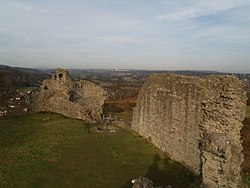Caergwrle Castle
| Caergwrle Castle | |
|---|---|
| Caergwrle, Flintshire in Wales | |

Ruins of Caergwrle Castle with town of Caergwrle below
|
|
| Coordinates | 53°06′26″N 3°02′14″W / 53.107290°N 3.037164°W |
| Type | Castle |
| Site information | |
| Condition | Ruins remaining. |
| Site history | |
| Built | Approx 1277 |
| Materials | Stone |
| Fate | Destroyed following fire. |
Caergwrle Castle (Welsh: Castell Caergwrle), also known as Queen's Hope in scholarly texts, is located in the town of Caergwrle, in Flintshire, Wales. It was built by the Welsh under Dafydd ap Gruffydd in service to Edward I of England. When Dafydd's forces rebelled against the English, Edward sent Reginald de Grey, 1st Baron Grey de Wilton to take the castle in June 1282, but Dafydd had retreated and sabotaged the structure. Rebuilding works began, and it was given to Edward's wife, Eleanor of Castile. A town was planned at the base of the castle, but this was abandoned after a fire broke out in September 1283 when both Edward and Eleanor were present. It was passed down the royal line, but was never rebuilt. In 1823, a workman discovered the Caergwrle Bowl near the castle; it is a unique bronze age bowl.
Built on the south west corner of a steep hill near the Anglo-Welsh border, Caergwrle Castle has views which extend far into Cheshire. The foundations are made up of gritstone, locally quarried from Caergwrle hill, north west of the castle. There are two styles which appear in the masonry, with the most elaborate work taking place near the residential areas of the castle and on the exterior portions. During use the interior walls would have been plaster-covered, obscuring any masonry and therefore making detailed work unnecessary.
The west curtain wall is no longer present, nor is the majority of the south tower. The crag under which the south tower would have partially stood is missing, which may have been an indication of quarrying close to the castle itself. The hilltop was known for being used as a quarry for the construction of millstones during the 17th century. Following the destruction of the castle, looting took place. This resulted in several of the remaining walls missing large stones illustrating this taking place on an individual basis, as well as large sections of the castle entirely missing indicates that this would have taken place on an industrial scale. Historians suspect that the west wall and majority of the south tower was removed through those means, as it would have been easier to take apart and roll down the steep hill than other parts of the castle.
...
Wikipedia
